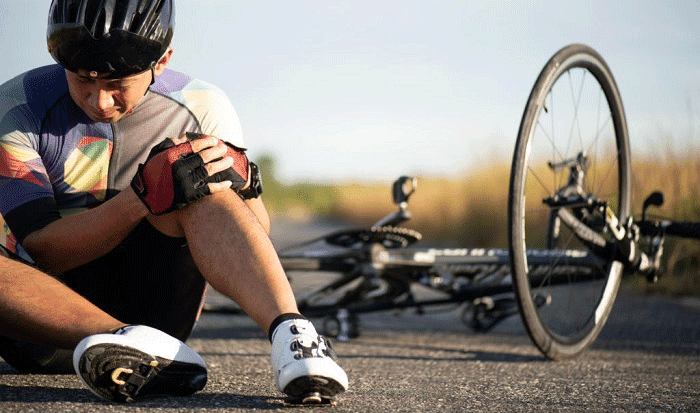Do you ever wonder why bike crashes occur? And why does knowing the specific cause help? Simply because it allows the driver to be held accountable.
Bike accidents, especially on highways, are caused by different factors. Most of them are driver-related accidents that involve dangerous lane changes.
Learning the most common causes of bike crashes can help save your life whether you go for a leisure ride, exercise cycling, or a typical daily commute. This also allows us to be ready for the risks every time we hit the road. Read about it here.
Table of Contents
- Common Causes of Bike Crashes
- 1. Speeding
- 2. Distracted Driving
- 3. Failure to Provide Enough Buffer
- 4. Moving Around Traffic Areas
- 5. Careless Lane Changes
- 6. Changing direction Without Checking
- 7. Passing a Stop Sign or a Red Light
- 8. Failure to Yield
- 9. Driving Under the Influence
- 10. Dooring accidents
- 11. Driver fatigue
- 12. Aggressive driving collisions
- 13. Rear-end collisions
- 14. Blind Areas
- Areas Prone to Bike Accidents
- Few Ways to Avoid Accidents
- Conclusion
Common Causes of Bike Crashes
An automobile or cab is the most usual vehicle engaged in crashes involving bikes. A biker is usually hit from the back of the car. The front side of the vehicle usually collides with the back of the bike in a quarter of tragic cyclist incidents.
Bike crashes are most common when bikers ride on public roads and can be caused by various circumstances, many of which are related to drivers.
Dangerous lane shifts, driving without checking for bicycles, driving dangerously to bike routes and shoulders, and the use of cellular phones while driving are all common reasons.
Let us tackle the next part, which talks explicitly about bicycle crashes and their causes.
1. Speeding
Excessive speed extends the time required for drivers to slow down while reducing their decision-making time on the roadway.
Although high-speed collisions are more prone to a severe and fatal bike accident, low-speed collisions (such as when a car drives through a quiet area) can also be really hazardous for bikers.
2. Distracted Driving
All forms of vehicle crashes, including those involving bikes, are caused by distracted or impaired driving. Drivers preoccupied with their phones rather than their surroundings are much more likely to cause fatal accidents.
Viewing and replying to texts and emails, calling contact information, conversing on the cellphone, and using social networks are all common kinds of distraction.
3. Failure to Provide Enough Buffer
Drivers that pursue bikes too nearly and go within 3 feet of them needlessly put themselves in highly hazardous circumstances.
These individuals are not just more likely to strike riders, but they often provide bikers (and themselves) fewer options for avoiding a bike accident, crash, and other incidents.
4. Moving Around Traffic Areas
Bikers driving on the road are unlikely to be seen by drivers moving through crowds. They’re also less likely to escape crashes by making evasive moves.
Moving motorists frequently stray from traffic lanes and onto bicycle lanes and sidewalks, making it another common factor for a bicycle accident.
5. Careless Lane Changes
One careless and sudden lane shift without paying attention to other vehicles is very dangerous.
The majority of cyclist accident today involving hazardous changing lanes occur when vehicles merge into bikers’ paths without checking to see if the route is clear.
6. Changing direction Without Checking
Similar to accidents caused by careless lane changes, the lack of observation leads to dangerous situations when changing directions.
Drivers receive a green signal to proceed at numerous junctions while being required to look for bikes and pedestrians. At crossroads, turning before scanning for bikers are one of the common (and entirely preventable) causes of cycling accidents.
7. Passing a Stop Sign or a Red Light
Intersection accidents are frequently caused by drivers disregarding stop lights and signs.
While disregarding a road sign or light is risky, the dangers of a bike accident injury are amplified when drivers fail to look for cyclists who have the right of way.
8. Failure to Yield
People often wonder what failure is. Simply put, it’s a form of offhand or irresponsible driving that may result in severe risks for bike cyclists.
Roundabouts and intersection areas are where drivers are obliged to yield to the incoming car and bike traffic.
9. Driving Under the Influence
Many drivers, and not just cyclists, still insist on driving after drinking or taking drugs. Such irresponsible actions lead to many heartbreaking accidents.
Drunk driving reduces a driver’s capacity to make sound decisions and avoid fatal crashes, and many crashes involving cyclists occur as a result of driving while intoxicated.
10. Dooring accidents
When a person parks to open their driver’s side door along the road without looking, this is known as “dooring.”
Cyclists moving at high speeds frequently do not have enough chance to react before colliding with an open car door, which usually results in severe injuries of the individual cycling their bike.
11. Driver fatigue
Another common cause of bike accidents is driver fatigue. Although the dangers of driving when tired are far less than driving while intoxicated, research has demonstrated that they are intensely equivalent.
Drivers who are out early, late, or rushing to get home from a long day at the office are more likely to have serious accidents. Worse, it can even cause bike accident death.
Whatever happened, if you were critically wounded in a bike crash involving any vehicle, you should contact a personal injury attorney as quickly as possible.
12. Aggressive driving collisions
Bikers who share the highway with reckless drivers face a significant risk of road rage. A deadly accident can occur when a vehicle becomes agitated near a slower-moving bike.
13. Rear-end collisions
Bikes usually travel in the exact directions as the rest of the road traffic.
When a bicycle comes to a complete stop at a red traffic light, they have little control over what’s happening behind them, placing people at risk of being hit in a rear-wheel collision.
14. Blind Areas
When changing direction, lanes, or simply taking a turn, many cars don’t pay close attention to blind spots. Do note that bicycles are more manageable to miss than bigger cars because they are smaller.
Areas Prone to Bike Accidents
Intersections famously deadly for traffic crashes, the NHTSA reports that most fatal bike accidents (63%) do not happen there. Instead, they happened on highway roads and other places.
1. Urban Environments
According to NHTSA crash data, three-quarters (75%) of deadly bike crashes occur in urban settings, such as cities and downtown regions. Rural areas account for only 25% of fatal bicycle accidents.
2. Major Highways
For cyclists, national highways or roads are dangerous places. Heavy vehicle traffic and faster speed limitations raise the danger of severe and fatal collisions in such areas.
Even though regulations exist to help bikers and automobiles commonly drive on the road, some people disregard or disrespect them, leading to motor vehicle and cyclist collisions or vice versa.
3. Driveway Access Roads
Since vehicles may still not stop to look for bicycles when turning into a walkway or cycling lane, driveways are unsafe for cyclists.
Few Ways to Avoid Accidents
Some accidents are unavoidable for a cyclist. In many cases, having a sense of awareness can help prevent a severe bike accident and, therefore, help to avoid injuries.
- Wear visible outfits. Because bicycles are smaller than most motor vehicles, you can decorate your bikes or wear more visible outfits, especially at night.
- Avoid Distractions. Please be aware of your environment, do not use the phones to listen to music or send texts. Pay attention to the road instead if you enter crowded spaces.
- Put on a helmet. A helmet can lessen the chance of head injuries and other neural damage. And it is not hard to find a lightweight and nice-looking helmet with proper protection. So, it is a must to wear one.
- It’s best to avoid biking at night. If you can resist cycling at nighttime, please do so.
Conclusion
And those are the most common causes of bike crashes. Knowing them is a total life-saver because we can readily assess everything that happens on the road, eventually avoiding accidents.
However, knowing them is not enough because we have to take preventive measures.
- Always put on a helmet to avoid fatalities during collisions.
- Focus on the road.
- Wear visible clothing.
- Be careful when going through areas that are prone to accidents.

“I ride my bike to work for years, but is that enough? Our carelessness towards our surroundings has taken a toll on the environment. And now, everyone is responsible for changes; even the most minor contribution is counted. With this hope and spirit, I started with my partner to establish Biketoworkday to help more individuals commute to their work sites on their bikes.”



